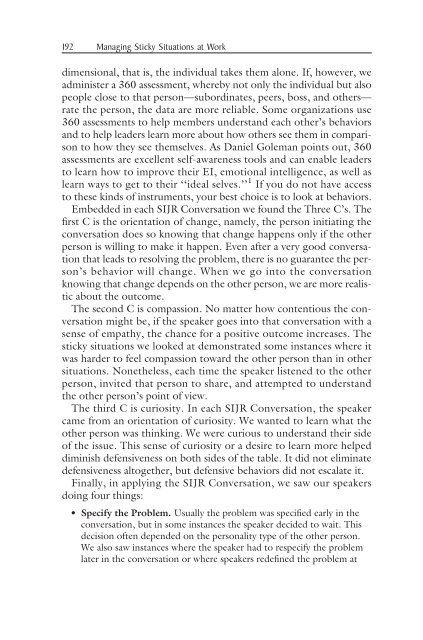Managing Sticky Situations at Work
Managing Sticky Situations at Work
Managing Sticky Situations at Work
Create successful ePaper yourself
Turn your PDF publications into a flip-book with our unique Google optimized e-Paper software.
192 <strong>Managing</strong> <strong>Sticky</strong> <strong>Situ<strong>at</strong>ions</strong> <strong>at</strong> <strong>Work</strong>dimensional, th<strong>at</strong> is, the individual takes them alone. If, however, weadminister a 360 assessment, whereby not only the individual but alsopeople close to th<strong>at</strong> person—subordin<strong>at</strong>es, peers, boss, and others—r<strong>at</strong>e the person, the d<strong>at</strong>a are more reliable. Some organiz<strong>at</strong>ions use360 assessments to help members understand each other’s behaviorsand to help leaders learn more about how others see them in comparisonto how they see themselves. As Daniel Goleman points out, 360assessments are excellent self-awareness tools and can enable leadersto learn how to improve their EI, emotional intelligence, as well aslearn ways to get to their ‘‘ideal selves.’’ 1 Ifyoudonothaveaccessto these kinds of instruments, your best choice is to look <strong>at</strong> behaviors.Embedded in each SIJR Convers<strong>at</strong>ion we found the Three C’s. Thefirst C is the orient<strong>at</strong>ion of change, namely, the person initi<strong>at</strong>ing theconvers<strong>at</strong>ion does so knowing th<strong>at</strong> change happens only if the otherperson is willing to make it happen. Even after a very good convers<strong>at</strong>ionth<strong>at</strong> leads to resolving the problem, there is no guarantee the person’sbehavior will change. When we go into the convers<strong>at</strong>ionknowing th<strong>at</strong> change depends on the other person, we are more realisticabout the outcome.The second C is compassion. No m<strong>at</strong>ter how contentious the convers<strong>at</strong>ionmight be, if the speaker goes into th<strong>at</strong> convers<strong>at</strong>ion with asense of emp<strong>at</strong>hy, the chance for a positive outcome increases. Thesticky situ<strong>at</strong>ions we looked <strong>at</strong> demonstr<strong>at</strong>ed some instances where itwas harder to feel compassion toward the other person than in othersitu<strong>at</strong>ions. Nonetheless, each time the speaker listened to the otherperson, invited th<strong>at</strong> person to share, and <strong>at</strong>tempted to understandthe other person’s point of view.The third C is curiosity. In each SIJR Convers<strong>at</strong>ion, the speakercame from an orient<strong>at</strong>ion of curiosity. We wanted to learn wh<strong>at</strong> theother person was thinking. We were curious to understand their sideof the issue. This sense of curiosity or a desire to learn more helpeddiminish defensiveness on both sides of the table. It did not elimin<strong>at</strong>edefensiveness altogether, but defensive behaviors did not escal<strong>at</strong>e it.Finally, in applying the SIJR Convers<strong>at</strong>ion, we saw our speakersdoing four things:• Specify the Problem. Usually the problem was specified early in theconvers<strong>at</strong>ion, but in some instances the speaker decided to wait. Thisdecision often depended on the personality type of the other person.We also saw instances where the speaker had to respecify the probleml<strong>at</strong>er in the convers<strong>at</strong>ion or where speakers redefined the problem <strong>at</strong>















